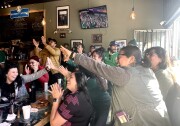In one of the oldest neighborhoods in Los Angeles, in a more than 100-year-old, rose-colored California Craftsman, Andrea Martinez Gonzalez points to a doorbell at the bottom of one of the homes’ two staircases.
“That’s for the servants,” explained Gonzalez, the homeowner. “In most of these grand homes, there were two staircases, because the servants dare not come down the main staircase.”
Gesturing out front toward the street, in an area that seems more San Francisco than Southern California, she emphasizes the abundance of open space between each home.

“All of the homes in this neighborhood had these enormous driveways back then,” she said. “Not like these days.”
The neighborhood is Angelino Heights, a tiny, enclave nestled between Chinatown and Echo Park. It sits more than 500 feet above downtown — hence the name — with sprawling views of the city. “Back then” was the mid-1880s, when many of the quintessential homes in Angelino Heights were built. More architecturally diverse than anywhere in Los Angeles, it’s a microcosm of the city’s colorful architectural development.
“These homes were built by the titans of industry,” Gonzalez said.
A Family Home
Gonzalez, 73, has lived in Angelino Heights her whole life. She attended Belmont High in the 1960s, and remembers afternoons spent frolicking at Echo Park Lake with her friends.
Her grandparents migrated to the United States during the Mexican Revolution in the early 1900s through Arizona, paying “two cents to cross the bridge into the United States. No papers, nothing. Just pay your toll and you're in,” she recalled.
Eventually, they bought this home in Angelino Heights, where she grew up. And as their only grandchild, Gonzalez inherited it when they died.
“Probably if I wasn’t so fortunate, I would have ended up back in Mexico by now,” Gonzalez said.
How Angelino Heights Came To Be
Angelino Heights was founded at the height of the Southern California land boom in the mid-1880s. Built as a suburb for upper middle class Angelenos working downtown, it paved the way for the development of the array of Queen Anne-Eastlake Victorians that can be seen today.
New development came to a halt in 1888 due to the banking recession. But as film studios began to pop up nearby, a second wave hit the area from 1900 to 1915, bringing the Craftsman/California Bungalow style. To accommodate an influx of mostly Mexican immigrants to the area after World War II, many of these large homes were then converted into multifamily residences.
-
Gonzalez was a guest on the How to LA podcast after she wrote us about her neighborhood for a segment idea. If you'd like us to visit your neighborhood and give us a tour, let us know here.
The streets are now lined with a collection of Queen Anne and Eastlake Victorians — the highest concentration in the city — along with Craftsman/California bungalows, Brownstones and Streamline Moderne homes.
In 1983, Angelino Heights became the city’s first Historic Preservation Overlay Zone (HPOZ). This means homeowners can’t remodel the exterior, and requires any new construction to resemble the original architecture. It also requires residents to get HPOZ committee approval before making any cosmetic changes to the outside of the home, like painting.
Now, there are more than 20 HPOZ districts in the city, including West Adams, Hancock Park, Miracle Mile and Pico Union.
The Neighborhood’s Phases
Living through so many generations in one place, Gonzalez has witnessed the neighborhood and its many phases.
-
What candidates can — and can't — say they do
-
Nonprofit's launching fundraiser to keep it afloat
-
USC study documents what residents want from trees
The most recent iteration — an influx of young millennials spilling over from ultra-hip Echo Park — sent real estate prices soaring. Gonzalez said her grandmother bought the house in 1963 for around $9,000. Recently, she was offered more than $1 million, which she quickly declined, she said.
“For the homeowners, it's been a bonanza,” Gonzalez said, “For the renters, it's been horrific and a tragedy.”
Of course, housing affordability is a critical issue in nearly every corner of Los Angeles. In a recent poll by the Los Angeles Times and UC Berkeley, Angelenos reported it to be their third most pressing concern, just behind homelessness and crime.
Still, Gonzalez holds a sympathetic view for the newcomers.

“I don’t mind the cultural change,” she said. “People are people.”
Certainly, the gentrification of Angelino Heights and throughout Los Angeles has been a tragedy for many, as Gonzalez put it. But this also means that some unsuspecting homeowners were blessed with good timing, like Gonzalez’ Mexican American neighbors who recently sold their bungalow for more than $1 million. With the generous profit, they bought a plot of land back in their hometown in Mexico.
“They built their tiny house, and they were happy,” Gonzalez said. “There’s a lot of people who are angry, and I get it, but there are a lot of people who aren’t.”
Hollywood in Angelino Heights?
Angelino Heights’ epic homes have also served as backdrops in various film and TV sets. The Charmed House, the home featured in the cult-favorite early 2000s TV series Charmed, is on Carroll Avenue. Michael Jackson’s Thriller music video was filmed at a home on the same street, and the house belonging to Vin Diesel’s character in The Fast and the Furious films is the area (though the filming of future Fast and Furious movies have been fiercely protested by residents due to the dangers of drag racing).
But for Gonzalez, she doesn’t care about the neighborhood’s features in Hollywood or its rapidly gentrifying culture. As a former historian, it’s Angelino Heights’ old roots that make it feel like home, she said.
“It’s what calls me. You have a feeling of hometown,” Gonzalez said. “I'm not into minimalism and boxes. I love living in the past.”










